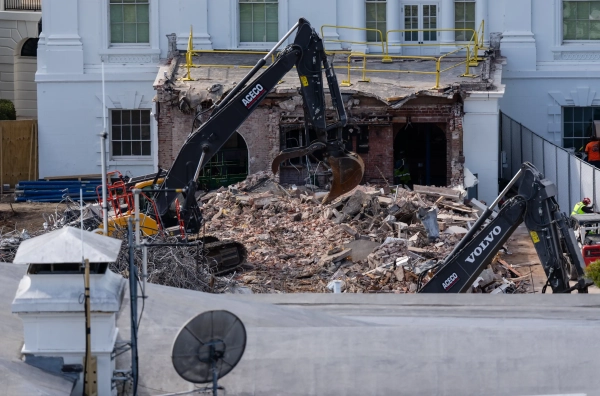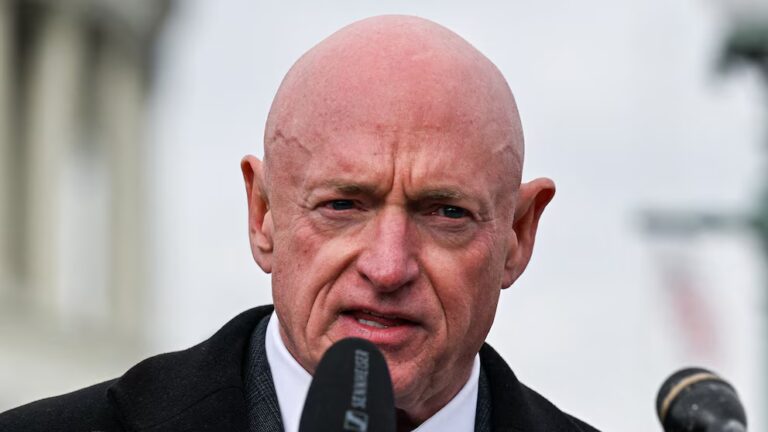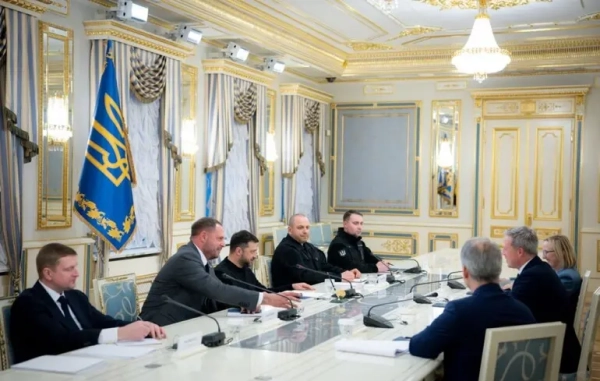
The East Wing of the White House is no more. With its vanishing, President Donald Trump proceeds to reshape history, notably the traditions regarding how a US president might employ a bulldozer on the “people’s house.”
In Trump’s view, the East Wing necessitated obliteration to accommodate a 90,000 square foot grand hall for hosting international envoys and 999 attendees. This colossal $350 million undertaking, he stated, will be bankrolled by private benefactors.
The sweeping images depicting the demolition triggered profound sentiments spanning from dismay to rejoicing, and provoked inquiries into the implications of this revamped White House for ordinary citizens of the US.
“[There are] individuals who perceive it as symbolizing affluence; that undoubtedly possesses an inspirational quality,” remarked Debbie Millman, designer and instructor at the School of Visual Arts situated in New York City. “However, that is not the reality for most Americans.”
We engaged in conversation with Millman regarding Trump’s record of annihilating historical items and inflaming the populace. It’s a legacy inaugurated by his father, Fred Trump, and maintains a common thread with the architectural visions of monarchs and strongmen.
Featured below is a segment from the dialogue, trimmed for brevity and lucidity. The complete podcast offers significantly more insights, so tune in to Today, Explained through your preferred podcast platform, including Apple Podcasts, Pandora, and Spotify.
What immediate feeling arises from what you’re witnessing transpiring at the White House presently?
Oh, my immediate feeling is one of anguish. It’s genuinely disheartening to observe the unfolding events, to witness the dismantling, to observe the demolition of this significant wing of the White House. Essentially, he has executed this autonomously, devoid of input or counsel from preservation advocates or historians. He has not secured any approval, whatsoever, to undertake such an action.
Upon visiting the White House website, they have cunningly presented a historical catalog of past renovations that have taken place. However, those endeavors were invariably conducted with the endorsement of historians, preservationists, and architects who maintained transparency regarding the activities, complete with schematics. Thus, a subtle ruse is at play here, wherein there seems to be candor concerning the proceedings. Yet, it’s merely a facade. No floor plans have been circulated. A limited number of ambiguous sketches have been shared, yet [they] fail to comprehensively delineate the internal alterations beyond a superficial footprint.
President Trump is not renowned for exercising moderation. Correct? He gravitates towards grandeur, he favors gold accents. He embraces elements that certain individuals might deem tasteless or flamboyant.
Upon evaluating public sentiment regarding this refurbishment, certain observers interpret these aesthetic preferences as embodying prosperity, as reflecting accomplishment. Essentially, one person’s tackiness is another’s “Hey, that’s stunning.” Is there a rationale suggesting that the “people’s house” ought to mirror the individual whom the citizenry has elected, thereby mirroring us?
The response hinges substantially on one’s convictions regarding representation. Individuals who do perceive it as epitomizing prosperity — that certainly can hold aspirational appeal, yet that remains beyond the reach of most Americans. This constitutes the “people’s house.” It transcends a single individual’s abode. And Mr. Trump is in the process of erecting a citadel or a majestic residence.
President Trump has consistently regarded architecture as a vehicle for self-expression, akin to his father’s actions in 1966. [Fred Trump] razed a 19th-century recreational park located in Coney Island and pledged to safeguard certain historical attributes, a commitment that went unfulfilled. Instead, they hosted a festivity at the demolition locale. Incredibly, bikini-clad models sporting hard hats were present, and Fred Trump distributed bricks for attendees to hurl at the historic pavilion’s glass facade, thereby dismantling and obliterating it, as opposed to conserving it for posterity.
Subsequently, [Donald] Trump emulated this conduct in 1980; he demolished the Bonwit Teller edifice on Fifth Avenue to pave the way for Trump Tower, and pledged the limestone art deco sculptural reliefs to the Metropolitan Museum of Art, only to annihilate them. When subsequently questioned about the incident, he shrugged dismissively, demonstrating a sense of contempt rather than reverence. This behavior is not unprecedented for him. And it underscores a deficiency in regard for history. It signals a deficiency in regard for the preservation of artifacts that possess significance and value, in order to fabricate something that primarily caters to his own self-interest.
My familiarity with the annals of the White House is limited, yet I infer that President Trump isn’t the inaugural president to dabble with the premises. By and large, these figures possess considerable egos and envision themselves as pivotal leaders. What transformations have transpired historically, and does Trump’s endeavor significantly diverge?
Well, the nascent grand ballroom spans an estimated 90,000 square feet. Certainly, it is not the first remodeling intervention within the White House. Thomas Jefferson broadened the grounds. He fashioned gardens that mirrored his values. Franklin Roosevelt transferred the Oval Office to the southeastern quadrant of the West Wing, yet the extant office was rather somber and constricted, thereby prompting him to infuse greater illumination and accessibility into the office. Harry Truman oversaw the interior’s overhaul.
Nevertheless, a substantial portion of that initiative stemmed from the perceived imminent failure of building segments that were deemed so hazardous that recourse was inevitable. Naturally, Jacqueline Kennedy — her revitalizing project emphasized historical congruity. She also manifestly conceived the Rose Garden. She invested extensively in the grounds, all of which had undergone obliteration. [Editor’s note: In July, Trump paved over the Rose Garden to create a tiled patio.]
Thus, this does not constitute the initial episode of White House component eradication that Trump seeks to repurpose as an arena predominantly designated for jubilant festivities or gatherings, as opposed to [for] imperatives rooted in augmented safety or safeguarding or enhancement on behalf of the citizenry, as opposed to [for] wealthy donors.
Granted, past presidents have modified the White House, yet you contend that this defies comparison. Assuming the absence of a genuine parallel within the US, are there corresponding instances elsewhere, involving global leaders who have engaged in analogous conduct?
Indeed, significantly so. Louis XIV’s verdict concerning Versailles’ blueprint transmuted a royal dwelling into a stage whereupon his governance would, in essence, be enacted. Similarly, Benito Mussolini’s marble plazas endeavored to interlace fascism with Rome’s grandeur. In this course, entire vicinities were demolished to forge the Imperiali boulevards.
Within Versailles and fascist Rome, architecture served to amplify a leader’s dominion by recasting the significance of the nation’s most prominent symbols. Fundamentally, that epitomizes Trump’s actions here. It transcends a pragmatic addition; it embodies a metaphor wherein the Trump trademark eclipses the institution.
There remains no disputing the inherent worth of a ballroom. The prevailing ballroom accommodates approximately 250 individuals. When the White House has arranged more substantial gatherings, it has resorted to erecting tents on the lawns. Such arrangements were not invariably pragmatic or conducive. In inclement weather, attendees were relegated to traversing plastic sheeting. However, such stipulations do not vindicate the necessity for an ostentatious showpiece deficient in reflecting the nation’s essence. Gilded flourishes are alien to the nation’s core, unequivocally.
You command expertise within your discipline. And President Trump has instigated a phenomenon within America that merits intrigue: He has cast aspersions on the worth of specialists, in lieu of the regular citizen, the average individual. Hypothetically, he might articulate, “I garnered democratic election through the ordinary citizenry. These ordinary individuals endorse my actions, and should I elect to reconstruct the White House in my image or through an alternate lens, that course secures the approval of ordinary Americans.”
Madam Expert, what are your impressions concerning that thesis?
Well, this endeavor constitutes neither a reflection of nor a tribute to the populace. The ballroom will effectively rewrite the White House’s identity, transmuting it into an extension of the Trump trademark. The fact that this construction has been financed by and designated for billionaires in return for acknowledgment of their personal trademarks as integral components of the building itself refutes that assertion.
According to my viewpoint, one of the predominant principles of a brand involves the capacity to abstract the logo while preserving the brand’s identity. Do these renowned assets evoke resonance beyond the brand’s appellation? The building that stands will be reshaped in the likeness of President Trump. It will be distinguished by pronounced ostentation — characterized by a truly exaggerated and ponderous scale. This proclivity manifests a predilection for magnitude over substance, and magnitude over refinement, and magnitude over dignity. This will challenge the integrity of the prevailing architecture of the White House in ways that we cannot yet completely apprehend. And I believe it’s transforming what has been, and will continue to be, described as “the people’s house” into a staging ground for Trump’s personal self-promotion.
Source: vox.com






